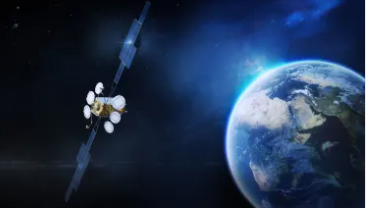BEAM
By analogy with a beam of light, indicates a unidirectional flow of radio waves emitted by an antenna and concentrated in a particular direction. The intersection of a satellite beam with the earth's surface is referred to as the footprint. A beam is steerable when it can be repointed in orbit towards another coverage zone by mechanical or electrical means.
CO-LOCATED
Describes a satellite that occupies the same control window on the geostationary satellite orbit as another satellite or satellites, such that the angular separation between them is very small when viewed from the ground. When a small receive antenna is pointed towards colocated satellites, the satellites appear to be at exactly the same position. In reality, they are kept at least several kilometers apart from one another through respective orbits that use slightly different values in terms of inclination and eccentricity.
COVERAGE
The geographical area where satellite signals can be recevied with sufficient quality when using appropriately sized earth stations. Satellite coverages are usually communicated in the form of footprints displaying satellite G/T, e.i.r.p., or another parameter such as the antenna size required for good quality reception of a particular service.
DIGITAL SIGNAL
Describes a system where information is converted into numbers, instead of into a continuously-varying quantity (as in an anaologue system), thereby reducing the necessary bandwidth. One 36 MHz transponder can carry a multiplex of eight to ten video channels in MPEG2 compression format.
DVB
Digital Video Broadcasting. A set of standards for the transmission and reception of digital video signals via satellite, cable or terrestrial means, formalised by the European Telecommunications Standards Institute (ETSI). There are many standards within the DVB family, including specifications for satellite (DVB-S), cable (DVB-C) and terrestrial (DVB-T) transmission and reception.
E.I.R.P.
Equivalent Isotropically Radiated Power. Measures the strength of the signal transmitted by a satellite towards the earth or by an earth station towards a satellite. It is expressed in dBW. The higher the e.i.r.p., the more the G/T can be reduced to obtain the same quality of reception (and the smaller the receive antenna can be).
EARTH EQUINOX (SATELLITE ECLIPSE)
During the equinoxes of March and September, the sun passes across the plane of the equator, which means that it is on the same plane as the geostationary orbit. Due to the rotation of the earth, this alignment means that the earth obstructs the sun for certain periods and the solar panels cannot generate energy. The duration of the satellite eclipse gradually changes as the equinox approaches, building up to a maximum of 70 minutes on the day itself. During these periods the satellite's storage batteries are used instead of the solar panels so that the satellite can continue to function normally.
EPG
Electonic Programme Guide. A graphical user interface generated by a digital satellite receiver and displayed on the user's TV set. It provides information about programme times and content carried on the digital signals received from the satellite. An EPG's main function is to help the viewer quickly locate and select programmes, but it can also be used for other interactive services.
FREQUENCY
Identifies the number of oscillations produced in a specified time, expressed in hertz. A hertz corresponds to one oscillation per second. Satellite transmissions are usually expressed in GHZ (billion hertz). The term "frequency spectrum" is used to describe a continuous range of frequencies. The frequency spectrum of the Ku-band alloted to satellite communications systems extends from 10.7 GHz to 14.5 GHz.
FREQUENCY RE-USE
A technique for using a specified range of frequencies more than once within the same satellite system so that the total capacity of the system is increased without increasing the allocated bandwidth. Frequency re-use requires sufficient isolation between signals using the same frequencies so that mutual interference between them is controlled and kept below an acceptable level.
Frequency re-use is achieved by using separate polarisations (horizontal/vertical for linear or left-hand/right-hand for circular) for transmission and/or by using satellite antenna (spot) beams using geographical zones which are sufficiently separated from one another.
HD (HIGH DEFINITION)
A digital TV picture's "definition" is expressed in millions of pixels per second and is essentially made up of the number of horizontal lines, the number of dots per line and the number of images downloaded per second. By multiplying the number of pixels per second by a factor of at least five, High Definition renders each plane extremely sharp, reproducing the 3D effect of the image originally captured.
HDR (HIGH DYNAMIC RANGE)
HDR more accurately represents scenes from outdoors by making the bright pixels on the screen even brighter, and the darks even darker. Brightness (or luminance) is measured in 'nits'. Most TVs today have a peak brightness of around 100 nits / nit= candela/m2/, whereas the peak brightness of an HDR television is around 1,000 nits – representing a 10-fold increase in the brightness of the highlights on the screen. This is considered a substantial improvement to the brightness and detail, delivering more realistic and engaging pictures.
HLG (HYBRID LOG GAMMA)
Invented by BBC and NHK, HLG was adopted by the ITU as an international standard (ITU-R BT.2100) in July 2016 for high dynamic range programme production and exchange. HLG is a scene-referred system, like conventional television. The signal represents relative light levels in the original scene, with a single mastering process adapted to give the same artistic effect on brighter or darker screens at home. Displays only need information on their own capability and environment to render the signal, metadata describing the mastering display is not required. HLG has native compatibility with standard dynamic range (SDR) televisions. The single distribution bitstream can be decoded by HDR receivers and also by existing SDR infrastructure, enabling broadcasters to accelerate time-to-market of their UHD content.
LNB
The Low-Noise Block converter (or LNB) is located behind the feedhorn of a satellite antenna. Its function is to amplify signals received and to lower their frequency (typically into the 950 to 2150 MHz band) so that they can be processed by the receiver, DVB-S terminal or demodulator. A "universal" LNB enables reception of the full range of Ku-band downlink frequencies (10.7 to 12.75 GHz).
MPEG COMPRESSION
Motion Picture Experts Group. A group established by the International Organisation for Standardisation (ISO), which prescribes international standards for compression coding of moving pictures and audio programmes. MPEG2 (in 1995) was the first video compression format used for television, bringing digital TV to the general consumer by satellite and cable. On average, MPEG2 can carry eight digital channels in the same space required for a single analogue channel. MPEG4 was already being used to stream video over the Internet when it was launched commercially for TV broadcasting in 2006. Its role is vital to the development of HDTV programming because it uses significantly lower bit-rates. HD in MPEG2 format requires at least 18 Mbps whereas MPEG4 needs only 8 Mbps.
PARABOLIC ANTENNA
An antenna whose principal reflector is shaped like a parabola. It can reflect parallel incoming signals by directing them to a single point of focus where the source is equipped with its LNB is located.
PAYLOAD
A satellite's payload is the element that enables it to fulfill its mission, i.e. for a communications satellite, the reception and processing of signals and their retransmission back to earth. The payload includes the satellite antennas and transponders but not the control, propulsion and electrical power equipment, which is part of the satellite platform (physical structure).
PLATFORM
The platform is where all the satellite pointing control, thermal regulation, propulsion and power supply functionality is located. The pointing control equipment has sensors to notify the satellite's orientation to the ground in order to maintain it correctly pointed to the earth. Steering usually employs a chemical or sometimes an electrical propulsion system. In a chemical propulsion system, the platform, in addition to the engines (nozzles), contains tanks of propellant and a pressurising gas (typically helium) which drives the propellant towards the engines.
The satellite is powered by photovoltaic cells to convert sunlight into electricity. The solar cells are situated on the satellite's "skin" (in the case of spin-stabilised satellites) or on deployable solar panels. The energy produced by solar cells is stored in batteries.
POLARISATION
Polarisation characterises the way a radio electric frequency propagates. It can be organised in more than one direction. Linear polarisation can be vertical or horizontal. A frequency can also propagate by turning like a corkscrew. In this case it is circular polarisation, either right or left.
POWER
The amount of electrical energy fed into or taken from a device or system in a specified time, expressed in Watt or dBW. The signal strength on the uplink or downlink of a satellite communications system is quantified by the power of the radio wave radiated by the transmit antenna.
RECEIVE SENSITIVITY (FIGURE OF MERIT G/T)
The sensitivity of a receive system is described by its figure of merit G/T (gain/noise/temperatrure). Sensitivity depends on the gain of the receive antenna (which increases with the surface area of the antenna and the frequency of the signal received) and the total noise of the electronic equipment used for reception (expressed in noise temperature). The higher the G/T, the more the transmit power can be reduced. Inversely, the higher the transmit power, the more the G/T can be reduced (i.e. the smaller the receive antenna required).
SET-TOP BOX
Any adapter that converts an external signal into content that can be displayed on a television screen. The Set-Top Box is connected to the TV set using a Scart socket, for example, or an HDMI.
TRANSPONDER
A transmitter-receiver device that transmits signals automatically when it receives certain pre-determined signals. The term "satellite transponder" is a signal processing unit which uses a single high-power amplification chain. Each transponder handles a particular frequency range (also referred to as "bandwidth") centred on a specific frequency and with a given receive polarisation for the signal. The transponder changes the frequency and the polarisation between reception of the signal from the earth station and its amplification and retransmission back to earth. There are multiple transponders on a satellite, each capable of supporting one or more communications channels.
UHD (ULTRA HD)
UHD is a format that enriches the viewing experience through a significant increase in megapixels, colour space, frame rate and dynamic range. UHDTV1, also known as 4K TV, offers 8.3 megapixels (3840x2160). By contrast, UHDTV2 (8K TV) provides 33.2 megapixels (7680x4320).



